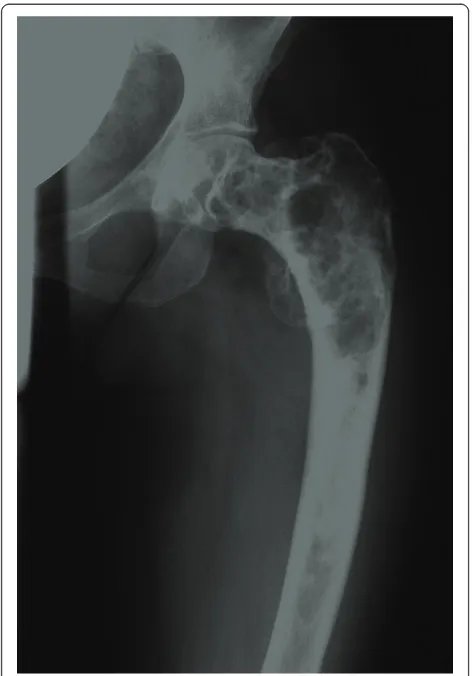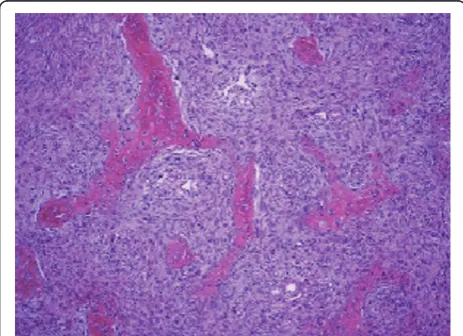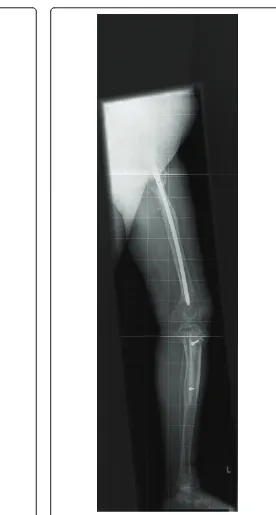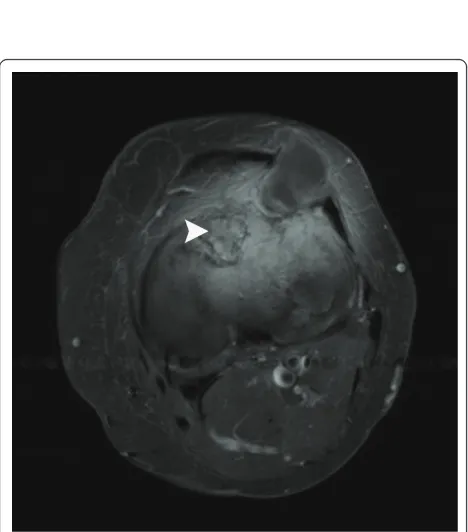C A S E R E P O R T
Open Access
Fibrous dysplasia of bone associated with
soft-tissue myxomas as well as an intra-osseous
myxoma in a woman with Mazabraud
’
s
syndrome: a case report
Wybren A van der Wal
1, Halil Ünal
2, Jacky WJ de Rooy
3, Uta Flucke
4and Rene PH Veth
5*Abstract
Introduction:Mazabraud’s syndrome is a rare but well-described disorder characterized by fibrous dysplasia in single or multiple bones associated with one or more soft-tissue myxomas. In this report, we describe what is, to the best of our knowledge, the first case involving an intra-osseous myxoma. This finding supports, and could provide new insight into, the pathological association between fibrous dysplasia and myxomas.
Case presentation:In this report, we describe the case of a 49-year-old Caucasian woman known for years to have fibrous dysplasia in the left femur and tibia who presented with progressive pain in her left leg and soft swelling in the left quadriceps region. After surgical intervention with excision of the soft-tissue mass, the diagnosis of Mazabraud’s syndrome was confirmed. During follow-up, our patient presented with a painless mass located on the lateral side of the left knee, next to a second, intra-osseous lesion with the same characteristics in the left lateral tibial plateau. The histopathological examination was consistent with a soft-tissue intra-osseous myxoma. Conclusion:In the international literature, 67 cases of Mazabraud’s syndrome have been described so far. To our knowledge, the present case report is the first to describe the combination of polyostotic fibrous dysplasia and intra-muscular as well as intra-osseous myxoma.
Introduction
Mazabraud’s syndrome is a rare but well-described dis-order. It is characterized by fibrous dysplasia, which can develop in a single bone (monostotic) or in multiple bones (polyostotic), associated with one or more soft-tis-sue myxomas.
The first case was described by Henschen in 1926 [1]. A pattern of association between fibrous dysplasia and soft-tissue myxomas was described by Mazabraudet al. in 1967 [2].
Fibrous dysplasia is a benign, intra-medullary, fibro-osseous lesion and usually develops in childhood or early adult life. In the 67 cases of Mazabraud’s syndrome described so far, most patients had the polyostotic form of fibrous dysplasia.
Soft-tissue myxomas are benign mesenchymal tumors. In Mazabraud’s syndrome, they usually occur (1) when the patient is at a more advanced age and (2) in close vicinity of the bones most severely affected by fibrous dysplasia.
We present the first case of a patient with Mazab-raud’s syndrome with an intra-osseous myxoma next to soft-tissue myxomas.
Case presentation
A 49-year-old Caucasian woman was referred to our center. She was known for years to have fibrous dyspla-sia in the left femur and tibia.
When she was 49 years old, an attempt was made to excise the fibrous dysplasia from the proximal femur. Extreme hemorrhaging complicated the operation. The attending orthopedic surgeon decided to refer the patient to our specialized center. At the time of her visit to our center, she complained about progressive pain in
* Correspondence: r.veth@orthop.umcn.nl
5
Department of Orthopaedic Surgery, Radboud University Nijmegen Medical Centre, Postbox 9101, NL-6500 HB Nijmegen, The Netherlands
Full list of author information is available at the end of the article
her left thigh and lower leg. Her clinical physical exami-nation revealed soft swelling in the left quadriceps region.
Conventional X-rays of the left leg showed typical features of fibrous dysplasia in the proximal femur (Figure 1) and the proximal tibia (Figure 2) with ground glass appearance and a shepherd’s crook deformity.
Magnetic resonance imaging (MRI) of her left leg showed extensive fibrous dysplasia in the entire femur with expansive growth in the greater trochanter. The left proximal tibia also showed signs of fibrous dysplasia extending 20 cm distally from the tibial plateau. Four well-delineated, cyst-like, intra-muscular soft-tissue lesions were seen in the quadriceps region. Surgery was planned in two sessions. Prior to both operations, angio-graphy and embolization of the pathologic vasculariza-tion in both the femur and the tibia were performed.
During the first operation, intra-lesional excision of the tumor of the left proximal femur was performed, followed by cryosurgery. A correctional osteotomy of the left hip was performed, followed by homologous
[image:2.595.303.539.85.590.2]bone transplantation and fixation with a proximal femoral nail. Because of a weakened femoral head, the femoral neck screw had to be stabilized with bone cement. Allograft bone chips were impacted to induce bone matrix. During the procedure, an incisional biopsy of the soft-tissue lesions in the quadriceps muscle was performed.
[image:2.595.56.292.355.693.2]Figure 1X-ray of the left femur. Anteroposterior plain film of the upper left leg with typical osseous changes consistent with fibrous dysplasia and shepherd’s crook deformity.
Three weeks later an intra-lesional excision of the fibrous dysplasia of the left tibia was performed, fol-lowed by cryosurgery and implantation of an massive allograft inlay in the tibia. The allograft was fixed with AO screws. During this procedure, the soft-tissue lesions in the quadriceps muscle were excised.
Microscopic examination of the bone lesions of both femur and tibia showed hypocellular fibrous tissue with irregular bone formations and without cytologic atypia compatible with fibrous dysplasia. In one lesion, the remnants of fracture callus were present (Figure 3).
The soft-tissue lesions showed a paucicellular tumor with spindle-shaped or stellate not atypical cells embedded in a loose myxoid alcian blue-positive inter-cellular matrix with sparse capillary blood vessels. Confocal microscopy revealed a thin fibrous capsule at the tumor margin; how-ever, at the interface with skeletal muscle, infiltration between the individual muscle fibers was evident, which is typical of intra-muscular myxomas (Figure 4), proving the diagnosis of Mazabraud’s syndrome in our patient.
Post-operatively, the patient’s treatment consisted of non-weight-bearing mobilization for three months in plaster of Paris. During follow-up, plain films were obtained at six-week intervals. Eventually, these images showed consolidation of the femur osteotomy and incorporation of the allograft.
Nine months post-operatively the patient developed progressive pain in the left thigh. Conventional X-rays showed protrusion of the femoral neck screw. Reposi-tioning of the screw was performed. Her post-operative follow-up with X-rays obtained regularly (Figures 5 and 6) was satisfactory.
Almost two years later the patient complained about a painless mass localized on the lateral side of the left
knee. A solid mass was felt anterolaterally of the proxi-mal tibia. Plain film radiographs did not show abnorm-alities; however, an ultrasound examination showed a homogeneous, hypoechogenic, soft-tissue mass with a cyst-like aspect. MRI showed a well-defined soft-tissue lesion in the lateral retinaculum and vastus lateralis muscle with a homogeneous high signal intensity on T2-weighted images and a homogeneous low signal intensity on T1-weighted images, consistent with fluid. A second intra-osseous lesion with an approximate dia-meter of 3 cm and the same signal characteristics and enhancement pattern was detected in the lateral tibial plateau (Figures 7 and 8).
The lesions were considered to be a new soft-tissue myxoma and a relapse of fibrous dysplasia in the proxi-mal tibia, respectively. Surgical excision of both lesions was performed without pre-operative biopsies, followed by cryosurgery and homologous bone implantation. A histopathological examination of the intra-muscular lesion showed a myxoma. As a unique finding, histo-pathological examination of the intra-osseous lesion in the lateral tibial plateau was consistent with myxoma as well (Figure 9).
During follow-up, MRI of the patient’s left leg was performed at regular intervals. These scans showed no signs of recurrence in the first post-operative years.
[image:3.595.306.539.88.258.2]Three years after her last operation multiple tumors in her left upper leg were felt, which raised clinical suspi-cions of myxomas. MRI scans showed five new soft-tissue lesions consistent with characteristics of myxoma in the upper and lower leg regions. All lesions were marked ultrasonographically and excised, followed by cryosurgery. Histopathological examination of all intra-muscular lesions confirmed the diagnoses. Post-opera-tively the patient recovered gradually. Every three
[image:3.595.57.289.513.681.2]Figure 3 Histology of fibrous dysplasia of our patient. Photomicrograph showing curvilinear, slender trabeculae of woven bone surrounded by cellular fibroblastic tissue. There is no osteoblastic rim at the bone-stromal interface.
months ultrasonography of her left leg was performed, which showed no signs of myxoma until 2009. By then, she had developed several new intra-muscular myxomas, which were not treated. At her last follow-up examina-tion in early 2010, our patient was in good condiexamina-tion.
Several myxomas had developed but were found to be stable on the basis of MRI.
Discussion
[image:4.595.254.530.82.597.2]Fibrous dysplasia in itself is not a rare disorder; it is reported to represent 5% to 7% of benign bone tumors [3]. Monostotic presentation is more frequent, and the
[image:4.595.58.299.88.598.2]Figure 5Anteroposterior X-ray of the whole left leg. Situation after fibrous dysplasia excision of the left proximal femur and left tibia with correctional osteotomy of the left hip and fixation with a proximal femoral nail, as well as allograft fixation with AO screws of the tibia.
lesions are thought to occur as a result of a develop-mental failure in the remodeling of primitive bone to mature lamellar bone and a failure of the bone to rea-lign in response to mechanical stress. These features result in substantial loss of mechanical strength, leading to pain, deformity, and pathological fractures [4]. The etiology of fibrous dysplasia has been linked to a muta-tion in the Gsa gene, leading to an increase in cyclic
adenosine monophosphate, which leads to so-called downstream effects important in the pathogenesis of fibrous dysplasia [5].
An intra-muscular myxoma is usually a solitary lesion that is not generally associated with any other clinically apparent abnormalities [6]. It is a rare, benign mesenchy-mal tumor that is hypovascular, never exhibits an epithe-lial component, and probably never recurs locally [6].
Multiple intra-muscular myxomas are rare and usually are associated with fibrous dysplasia, a condition known as Mazabraud’s syndrome. In Mazabraud’s syndrome, the polyostotic form of fibrous dysplasia is present in the vast majority of patients. In general, the onset of fibrous dysplasia antedates the appearance of intra-mus-cular myxomas, and the soft-tissue lesions become apparent many years later, usually in the fifth or sixth decade of life [5]. The sites affected are predominantly the large muscles of the thigh, shoulder, buttocks, and upper arm. To our knowledge, no Mazabraud’s syn-drome case associated with an intra-osseous myxoma has been reported to date.
[image:5.595.303.538.88.255.2]There are different hypotheses for the association between fibrous dysplasia and intra-muscular myxomas. Some authors have suggested a basic metabolic error in both tissues during the initial growth period [7]. Various authors have demonstrated thatGNAS1mutations exist in intra-muscular myxomas, which may play an
[image:5.595.57.292.88.326.2]Figure 7T1-weighted magnetic resonance imaging scan of our patient. Axial spin echo T1-weighted pre-contrast magnetic resonance imaging (MRI) scan of the left knee reveals two well-delineated masses (arrows) with a homogeneous low signal intensity in the lateral retinaculum and in the lateral tibia plateau.
[image:5.595.57.291.406.672.2]Figure 8T2-weighted MRI scan of our patient. This T2-weighted image shows identical thin rim enhancement and heterogeneous intra-lesional enhancement in both masses. These findings may suggest myxomatous masses. In contrast, fibrous dysplasia can be noticed in the anterior tibial plateau (arrowhead).
important role in tumorigenesis in intra-muscular myx-omas as well as in fibrous dysplasia [8].
The radiological diagnosis of fibrous dysplasia is gen-erally established by plain films. Being larger, polyostotic lesions are more commonly accompanied by deforma-tion, including coxa vara, the shepherd’s crook defor-mity, bowing of the tibia, and protrusion acetabuli [4].
Ultrasound and MRI can be helpful to detect soft-tis-sue lesions in patients with Mazabraud’s syndrome [9,10]. Both imaging modalities show circumscript, fluid-like lesions with a cystic or multi-cystic appear-ance. Therefore, recognition of Mazabraud’s syndrome with its known association of fibrous dysplasia and benign soft-tissue myxomas is of utmost importance to establish the final radiology-based diagnosis. However, histopathological confirmation is always mandatory.
Histopathologically, the characteristics of fibrous dys-plasia and intra-muscular myxoma are as described in this case report. Both lesions are completely benign, and malignant transformation in fibrous dysplasia is uncommon.
In many cases, treatment of fibrous dysplasia is not necessary, since the lesions are discovered incidentally on plain radiographs and are asymptomatic. Clinical observation through follow-up radiographs is warranted to verify that there is no progression.
Different studies have reported clinical improvement in patients with fibrous dysplasia after bisphosphonate therapy [11-13], although there is no histological evi-dence of abnormal osteoclastic activity in fibrous dyspla-sia of bone.
Surgical treatment of fibrous dysplasia may be neces-sary to correct a deformity, to prevent a pathological fracture, and/or to relieve pain in symptomatic lesions. Upper-extremity lesions can often be treated conserva-tively, but surgical intervention is required for many comparable lower-extremity lesions. Other factors influ-encing the type of intervention used are the size and biological behavior of the lesion and the patient’s age.
The use of curettage only (with or without autogenous cancellous bone grafting) is associated with a high risk of recurrence, since the cavity or graft of normal bone is replaced gradually by dysplastic bone in the healing pro-cess, returning the patient to the pre-operative state. Cortical allografts last longer, since these grafts show far less and slower internal replacement by host bone and are therefore preferable for reconstruction.
The treatment of intra-muscular myxomas is depen-dent on the extent of the lesions, and these lesions should be excised if pain or pressure symptoms develop [10,14]. Our limited experience in using cryosurgery in soft-tissue tumors such as myxoma has shown that cryosurgery could be a powerful tool for the eradication of these tumors [15].
Conclusion
Mazabraud’s syndrome is a rare disorder; hence the small number of publications in the literature since it was first described by Mazabraud in 1967.
According to a recent article, there have been only 67 reported cases to date [16]. Our present report will probably be the 68th case, but it is the first report describing the combination of polyostotic fibrous dys-plasia with intra-muscular and intra-osseous myxoma.
Consent
Written informed consent was obtained from the patient for publication of this case report and any accompany-ing images. A copy of the written consent is available for review by the Editor-in-Chief of this journal.
Author details
1Department of Orthopaedic Surgery, Sint Maartenskliniek, Postbox 9011,
NL-6500 GM, Nijmegen, The Netherlands.2Department of Orthopaedic Surgery,
Rivierenland Hospital, Postbox 6024, NL-4000 HA, Tiel, The Netherlands.
3Department of Radiology, Radboud University Nijmegen Medical Centre,
Postbox 9101, NL-6500 HB Nijmegen, The Netherlands.4Department of Pathology, Radboud University Nijmegen Medical Centre, Postbox 9101, NL-6500 HB Nijmegen, The Netherlands.5Department of Orthopaedic Surgery, Radboud University Nijmegen Medical Centre, Postbox 9101, NL-6500 HB Nijmegen, The Netherlands.
Authors’contributions
WAW did the literature research, studied the case, and composed the article. HÜ was a major contributor to the writing of the manuscript. JWJR reported the X-rays and MRI scans and contributed to the description of the radiological examinations. UF performed the histological examinations and contributed to the description of the pathological examinations. RPHV revised the manuscript critically. All authors read and approved the final manuscript.
Competing interests
The authors declare that they have no competing interests.
Received: 25 May 2010 Accepted: 27 June 2011 Published: 27 June 2011
References
1. Henschen F:Fall von ostitis fibrosa mit multipelen tumoren in den umgebenden muskulatur.Verh Dtsch Ges Pathol1926,21:93-97. 2. Mazabraud A, Semat P, Roze R:Apropos of the association of
fibromyxomas of the soft tissues with fibrous dysplasia of the bones in French.Presse Med1967,75:2223-2228.
3. Campanacci M:Bone and Soft Tissue Tumors: Clinical Features, Imaging, Pathology and Treatment.2 edition. New York: Springer; 1999. 4. DiCaprio MR, Enneking WF:Fibrous dysplasia: pathophysiology,
evaluation, and treatment.J Bone Joint Surg Am2005,87:1848-1864. 5. Marie PJ, de Pollak C, Chanson P, Lomri A:Increased proliferation of
osteoblastic cells expressing the activating Gsαmutation in monostotic
and polyostotic fibrous dysplasia.Am J Pathol1997,150:1059-1069. 6. Allen PW:Myxoma is not a single entity: a review of the concept of
myxoma.Ann Diagn Pathol2000,4:99-123.
7. Wirth WA, Leavitt D, Enzinger FM:Multiple intramuscular myxomas: another extraskeletal manifestation of fibrous dysplasia.Cancer1971, 27:1167-1173.
8. Okamoto S, Hisaoka M, Ushijima M, Nakahara S, Toyoshima S, Hashimoto H: Activating Gsαmutation in intramuscular myxomas with and without fibrous dysplasia of bone.Virchows Arch2000,437:133-137.
10. Kransdorf MJ, Murphey MD:Diagnosis please. Case 12: Mazabraud syndrome.Radiology1999,212:129-132.
11. Chapurlat RD, Delmas PD, Liens D, Meunier PJ:Long-term effects of intravenous pamidronate in fibrous dysplasia of bone.J Bone Miner Res
1997,12:1746-1752.
12. Lane JM, Khan SN, O’Connor WJ, Nydick M, Hommen JP, Schneider R, Tomin E, Brand J, Curtin J:Bisphosphonate therapy in fibrous dysplasia.
Clin Orthop Relat Res2001,382:6-12.
13. Liens D, Delmas PD, Meunier PJ:Long-term effects of intravenous pamidronate in fibrous dysplasia of bone.Lancet1994,343:953-954. 14. Silver WP, Harrelson JM, Scully SP:Intramuscular myxoma: a
clinicopathologic study of 17 patients.Clin Orthop Relat Res2002, 403:191-197.
15. Veth R, Schreuder B, van Beem H, Pruszczynski M, de Rooy J:Cryosurgery in aggressive, benign, and low-grade malignant bone tumours.Lancet Oncol2005,6:25-34.
16. Zoccali C, Teori G, Prencipe U, Erba F:Mazabraud’s syndrome: a new case and review of the literature.Int Orthop2009,33:605-610.
doi:10.1186/1752-1947-5-239
Cite this article as:van der Walet al.:Fibrous dysplasia of bone associated with soft-tissue myxomas as well as an intra-osseous
myxoma in a woman with Mazabraud’s syndrome: a case report.
Journal of Medical Case Reports20115:239.
Submit your next manuscript to BioMed Central and take full advantage of:
• Convenient online submission
• Thorough peer review
• No space constraints or color figure charges
• Immediate publication on acceptance
• Inclusion in PubMed, CAS, Scopus and Google Scholar
• Research which is freely available for redistribution



